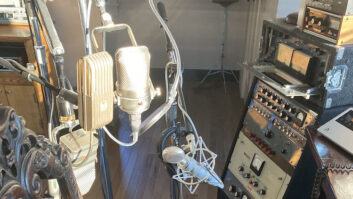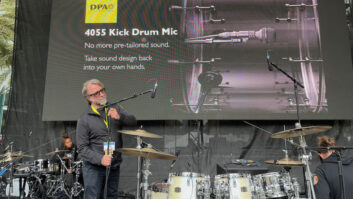Wireless technology has been very, very good to the audio industry. There are something like 400,000 wireless microphones in use in the United States alone — in concert halls, musical theaters from Broadway to elementary schools, houses of worship, film sets, sports arenas, conferences and conventions, and karaoke bars to name just a few of the venues in which they’ve taken hold in a big way. And wireless in-ear monitors have been a tremendous boon to the concert sound industry, protecting performers’ hearing and going a long way toward eliminating mud in the audience mix.
But wireless audio is in trouble, thanks to big changes coming in the television industry and the way the TV broadcast spectrum is used. That’s because their design takes advantage of holes in the spectrum that have been there since the dawn of TV broadcasting — and with the switch to digital television now mandated to be complete in three years, those holes are vanishing. Although the government is saying that there will be acres and acres of free spectrum opening up when we all get digital TVs, it looks like there may not be much room for wireless audio. “No one wants to tell you that the mic you bought last year might be nearly useless in three years,” says wireless technology consultant Gary Stanfill, “but privately, the manufacturers are highly concerned.”
In the world of analog television, interference between transmitters has always been an issue. So the rule has always been that you didn’t have two transmitters within 150 miles or so on the same channel nor did you have, in the UHF band, transmitters close to each other on adjacent channels. The FCC created a “table of allocation” for every geographic area, which dictates which channels could be used and which ones couldn’t. Wireless mics, because they were low-power and low-bandwidth, fit very nicely into the spaces left open.
But in the brave new world of digital television, there is theoretically no adjacent-channel interference. So when all analog transmitters go off the air in February 2009 (which was originally supposed to happen by the end of this year, but broadcasters managed to get the schedule pushed back — good thing, as hardly anyone I know actually owns a digital TV set), all those empty adjacent channels will now be usable. Rather than give those channels to other broadcasters, the FCC is going to shrink the UHF band, taking away everything above channel 51 and requiring existing broadcasters on those channels to move to the lower part of the band.
What’s going to happen to that suddenly available spectrum? It’s being sold off by the government for nonbroadcast purposes in auctions that will net the Feds an estimated $20 to $30 billion. Not everything is for sale; several channels are being allocated to public-safety, two-way radio broadcasts, hopefully to avoid the kind of communications breakdowns that famously occurred in the World Trade Center and New Orleans disasters. And channel 37 has been set aside for radio astronomy and medical telemetry. (The latter is in response to an early DTV test in Dallas that knocked out heart monitors on cardiac patients in two hospitals.) As for the rest, “No one really knows,” says Stanfill, an industry veteran and author who was president of wireless audio pioneer Vega Systems for some 18 years. “There will be various kinds of digital services like data transmission, point-to-point data links, WANs [Wide-Area Networks], metropolitan area networks — maybe a different form of TV.”
What we do know is that companies like Qualcomm are putting lots of money into large chunks of the spectrum. “When analog broadcasting ends,” says Stanfill, “two-thirds of the TV stations in the U.S. will change channels, and all of the people who’ve been waiting for their investment to pay off will fire up a gazillion transmitters up there above channel 51.”
That’s coming, but in the meantime, everyone who has worked extensively with wireless mics knows that RF interference already is often a problem. Another industry observer, who asked for anonymity, says, “At your average church in a place like Orlando, on any given Sunday, four out of eight wireless systems will experience such interference that they can’t be used. I know a guy in Raleigh, North Carolina, which isn’t exactly the entertainment capital of the world, who bought 14 premium systems, and he’s lucky if he can get 10 of them working at a time.” At the 2004 Republican National Convention in New York City, according to Edgar Reihl of Shure, more than 300 wireless frequencies were in use for microphones, intercoms, security and monitors. “But there was a special coordinator there appointed by the FCC,” he says. “They had to use every open TV channel and operate on top of some channels that were actually being used in outlying areas around the city. It took quite a bit to pull that off.”
Wireless mics are not the most powerful systems on the air: They can operate at 250 milliwatts, but Reihl — a 36-year veteran at Shure who is a technology director in the company’s Advanced Development department — says, “Almost none do, because battery life suffers and if you have a lot of transmitters operating in the same place at that power, intermodulation interference will get in the way. So they typically put out about 10 to 50 mW.”
And although a lot of people ignore the fact, wireless audio systems actually require a license and are really only supposed to be operated — in the TV band — by broadcasters and media producers. (Churches, following some arcane reasoning, are usually also allowed to fall into that category.) But according to Stanfill, only about 10 to 15 percent of the systems in use in the United States are properly licensed. “In theory, you can be busted for this by the FCC,” he says, “but unless you are incredibly stupid — which has happened, but not often — you’ll get by with a warning. Even that’s rare since the FCC doesn’t have the resources to police the whole country. But broadcasters especially need to be careful because any FCC problems can endanger their general broadcast license, which is worth a lot of money.”
So losing the no-longer-empty TV channels is going to make a tough situation worse. Unfortunately, there’s more. In 2004, the FCC floated a proposal to fill all of the “white space” in the spectrum — even in the lower 51 TV channels — with new unlicensed services. “The FCC’s policy is that there should not be a single hertz of spectrum from DC to purple light that no one is using,” is how Stanfill sums it up. The commission proposed two types of service: fixed-access, which would include services such as wireless ISPs, which could generate up to 4 watts of radiated power; and “personal portable” devices, limited to 400 mW, which could include home networks, video rabbits (the things that let you play your TiVo on a set in a different room) or even toys.
This doesn’t leave a heck of a lot of room for wireless audio, which Stanfill calls the Rodney Dangerfield of radio services: “It gets no respect. Even if you jump all these hurdles, you’re still last in line,” he says. “If someone interferes with you, you have no rights, but if someone claims you’re interfering with them, you have to stop.” And the irony is, you can go through the whole process to make your 20mW wireless mic system legal, and then, Stanfill says, “someone can walk into Best Buy and get something that will cleanly blow it off the air.”
Reihl doesn’t entirely agree with Stanfill. “Unlicensed devices are not allowed to interfere with any licensed services, including wireless microphones,” he says, “and they must accept any interference they receive from licensed services. However, the appropriate technical provisions have to be in place for this to work. But as a licensed secondary service, wireless microphones must not interfere with licensed primary services such as TV broadcasting.”
Besides the specter of someone coming into a meeting with a wireless BlackBerry and wiping out your audio, Reihl points out that unlicensed devices could have a serious negative effect on the very technology that the FCC is trying to advance. “Set-top and cable boxes are going to be vulnerable to interference from unlicensed devices,” he says. “The government is going to be subsidizing the transition to DTV by handing out converter boxes to low-income people with analog sets. It’s going to cost $1.5 billion. I don’t think they’d want to throw all that money out there and have it be a bust because of interference.”
After the FCC released it, the “white space” proposal lay dormant for a while. “Wireless audio companies, especially Shure, filed a lot of negative comments,” Stanfill says. “And there was a new chairman of the commission, and he had different priorities, so he didn’t push it. But now the large electronics companies are trying to do an end run around the commission by having their pet Congressmen file bills to push this forward, without even waiting for the DTV transition.” In February, U.S. Sens. George Allen and Ted Stevens, Republicans from Virginia and Alaska, respectively, introduced legislation that would force the commission to act within 180 days. Lest you think this implies some kind of neo-conservative plot, Allen’s bill was co-sponsored by Democrats John Kerry and Barbara Boxer. “The total U.S. market for wireless mics is about $150 million,” notes Stanfill, “but Intel makes more than that in a week. That buys a lot of lunches and campaign contributions.”
Intel and Microsoft have been lobbying very hard for quick FCC action, reports Reihl. But he is hoping to keep Congress from rushing to implement the proposal before it’s ready. He and fellow Shure technology director Ahren Hartman are active in an IEEE group that is trying to develop standards for the fixed-access systems that might end up in the white space. “Shure is the only wireless mic maker in the group,” Reihl says, “but there are others from the programming and production side, like CBS News and Fox, who are realizing they’re not just over-the-air services, they’re content providers. If the signal chain is broken anywhere along the way, it’s no good. We’re not working on the personal portable devices — there was an earlier group on that that couldn’t come to agreement. But we hope the IEEE will take that up later.
“Normally, Congress is inclined to let the FCC go about their business since they have the expertise,” Reihl continues. “But Congress has been lobbied very hard by a large range of special-interest groups. We’re hoping we can edge the legislators away from the deadline and give the IEEE and the FCC time to come up with a technical solution that works. We gave a Senate group a demo of what the interference will sound like: We set up a signal generator at 0.1 mW and showed them what it would do to a wireless mic, which they might be speaking through at a campaign appearance. It wasn’t pretty.”
Our conversation underscores that there’s another problem with wireless audio as compared to other data services: Audio is real time. “You can’t have latency in a business conference,” says Reihl, “or have the audio and video go out of sync. If a page hesitates while it’s loading on your Web browser, it’s no big deal. But if the audio fails in the middle of a political speech, that’s not going to work.” We both laugh ruefully when his cell phone blinks out in the middle of that last sentence, and I have to make him repeat it.
“Shure plans to be in the wireless business down the road even if no one else is,” says Stanfill. “They sell more than $50 million a year, so they are probably spending $300,000 or $400,000 a year trying to make the best of the situation — hiring lawyers and putting two engineers on it full time. They’re investigating technology that would work around the issues in the TV band or else be in a different band. It’s now all proprietary, and most of what they’re working on isn’t going to pan out, but they’re giving it a shot.”
What Reihl can talk about are three solutions that his group is presenting to the FCC to protect wireless mics and other broadcast auxiliary services should unlicensed technologies be allowed to come into the TV band. The first is for the commission to specify exempt channels in each market. Two VHF and four UHF channels would be declared off-limits for unlicensed devices, providing relatively clear space for licensed users.
The second is to have wireless microphone systems include a “beacon” — a small transmitter that sends out a narrow-band digital signal at 250 mW to tell unlicensed devices which channels they can’t use. “Unlicensed devices have to monitor the area anyway for other devices using the same spectrum,” Reihl explains, “so they could be programmed to recognize this. It allows the spectrum to be flexibly allocated as needed for the time it’s needed.”
The third idea is even simpler: spectrum sensing. An unlicensed device would “listen” for the presence of wireless mics and avoid operating on the same channel. “It’s a useful solution,” says Reihl, “but only on a ‘best-efforts’ basis. There’s a pretty good chance the unlicensed device will interfere with a mic system it can’t hear.” Because the FCC proposal allows unlicensed devices to generate as much as eight times as much power as a typical wireless mic, “There’s a good chance it will step on the mic,” says Reihl.
Should the IEEE group not be successful, and should Congress rush into authorizing unlicensed devices in the spectral white space, we may be facing what my anonymous source says would be “a perfect storm” of factors that will make wireless audio all but impossible. “The FCC has generally done a horrible job of anticipating what’s going to happen,” says Stanfill. “It could end up like the CB craze of 25 years ago: the Old West in radio form. But in that case, they weren’t stepping on anyone else’s toes.” Adds Reihl, “It’s the first time we’ve seen them throw in an unlicensed service on top of a licensed service.”
“Nobody remembers history,” continues Stanfill. “The FCC was formed as the Federal Radio Commission in 1927 because there was exactly this kind of free-for-all going on.”
“We really need to get this worked out before it happens,” Reihl. says “There was an issue between Nextel and public safety over use of the 800MHz band, which took 10 years to solve, but that was using licensed facilities with fixed transmitters, which could be changed. You can’t do that with unlicensed stuff. Once you give this stuff to the general public for baby monitors and wireless phones, you’re not going to get it back.”
Paul D. Lehrman’s first wireless rig put out 40 watts and was operated with a telegraph key. His installation of Ballet Mécanique at the National Galley of Art has been extended through May 14.







